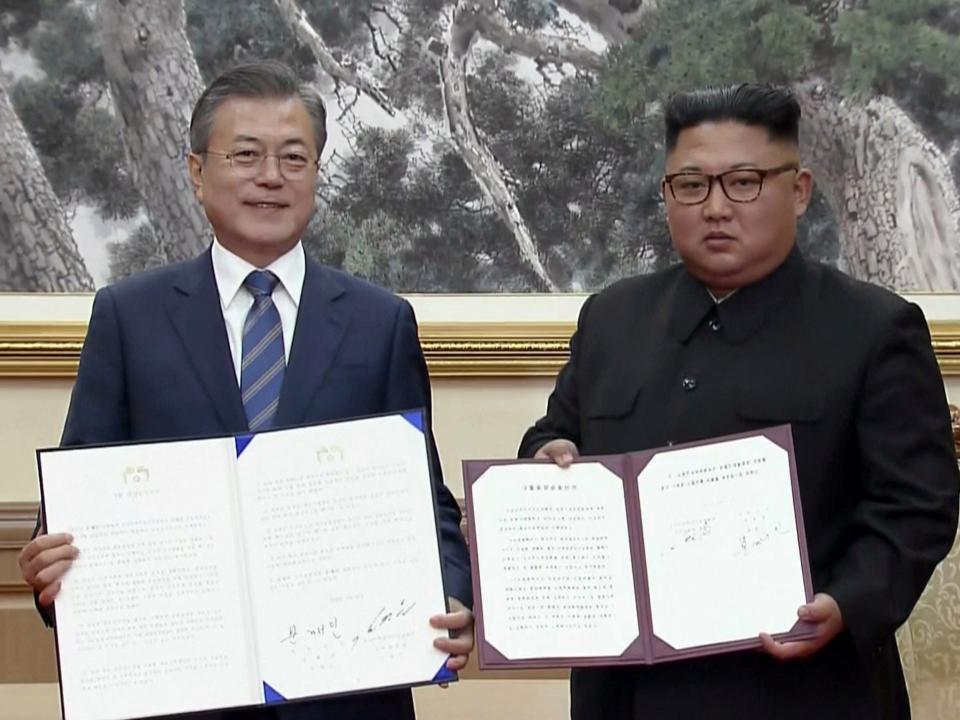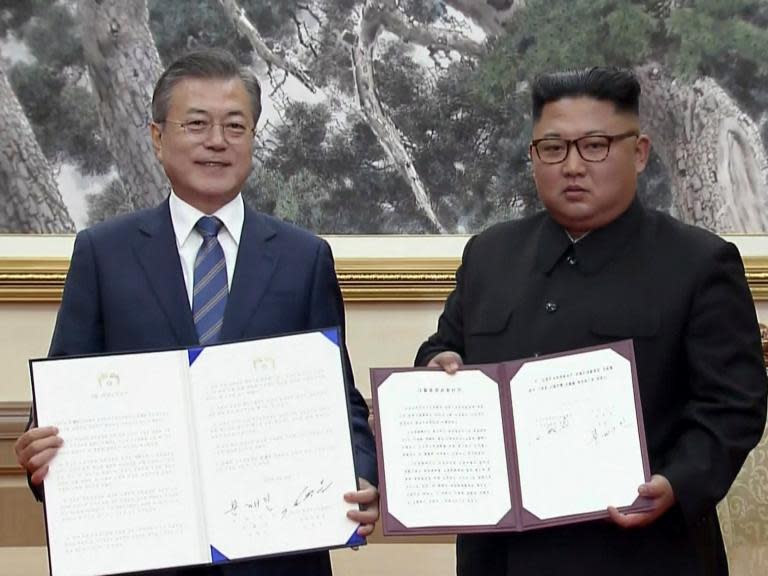The future of the Korean peninsula has never looked brighter than it does now
“The era of no war” has begun on the Korean peninsula, according to Moon Jae-in, the president of South Korea, midway through his summit meeting with his northern counterpart, Kim Jong-un. Critics and analysts have raised plenty of reasons to be pessimistic about the prospect. After all, this is not the first outbreak of “sunshine” in the 65 years since the Korean ceasefire was declared and the frostiest Cold War in history began. In the past, the joy of rapprochement proved short-lived: the clouds soon gathered once again, the rhetoric and missiles loosed off, and the North Koreans scuttled back towards their default position of truculent hostility to the rest of the world.
Is it different this time? There are always grounds for hoping so; but now joined by some for believing so.
In the first place, Mr Kim has already shaken hands with Donald Trump – a meeting that can fairly be described as an historic breakthrough – and the north and south have never enjoyed so much contact – now, vitally, reaching deeply into the issue of North Korea’s nuclear capabilities. That is the difference: both America and the two Koreas have leaders who want to end a war that is, technically, still going on and getting in the way of other priorities.
Second, and again in sharp contrast to the past, this time the North Koreans appear to mean business and are acting more sincerely – though the trust factor is still not fully in place. It is almost as if, having managed to launch rockets that have a chance of hitting the US west coast, the Democratic People’s Republic has decided to declare victory and move on – to dismantling the very facilities that delivered their strategic goal and status as a nuclear power. Nuclear and missile installations have already been destroyed; and others, it is promised, will follow, depending on unspecified reciprocal action from the US.
Given Donald Trump’s effusive tweets, some concession seem likely, and the second Trump-Kim summit will be put back on track. The North Koreans’ mild demands are certainly a highly encouraging sign.
What the DPRK appears to want is a formal peace treaty with the US, as the war ended in 1953 only with a truce between local commanders. Given the passage of time and the facts on the ground, there seems little reason to reject the request. However, diplomatically, the agreement would have to be with the United Nations, as the war was fought on behalf of the UN. Though obviously led by Americans, troops from Britain, New Zealand, Canada, even Ethiopia and Thailand, among others, participated. All the better for the spectacle of Pyongyang as host to a UN peace conference, and the centre of global attention.
For their part, the South Koreans, who have long had to live under the darkest clouds of northern aggressive intent, are making sure that symbolic and substantial achievements keep the momentum towards peace going. The joint industrial park at the border will be revived; tourists will return to the north; railways will be built across the demilitarised zone; border posts dismantled; military drills scaled back; no-fly zones established; and, most symbolically of all, there will be a joint bid for the Summer Olympics of 2032, almost half a century since the 1988 games helped Seoul confirm its emergence as a modern, democratic industrial power, now a member of the G20. Hyundai, Samsung and other groups could do much to transform North Korea’s economy, even under the rule of the Kim dynasty. The closer cooperation President Moon talks of, modelled perhaps on the European Union, will also make war less likely.
For any and all of that progress to be consummated, North Korea does need to press on with the public and independently verified destruction of its nuclear capabilities. This it has now signalled its willingness to do, especially at the important Yongbyon site, but President Trump will need to “jump together” with the north with some concession of America’s. From there, severe US and UN sanctions may start to be lifted, and the suffering of the North Korean people alleviated.
Thus far, Mr Trump’s idiosyncratic way of diplomacy, or “dealmaking” as he might term it, has worked surprisingly well. It would be churlish to deny him the credit for the revolution that is overtaking the region. In the background, throughout, is China, the Hermit Kingdom’s only friend in the world. It may be that, at long last, Beijing is both growing tired with its awkward ally and is seeing the sense in stabilising the situation, with the bonus that it would also help calm tense relations with the White House.
Some 100,000 North Koreans were corralled into shouting for Korean reunification during the motorcades that took President Moon and General Secretary Kim to their various destinations. That might not materialise even by 2032, but a two-regime, one-economy Korea could start to be constructed much sooner, with the north’s nuclear weapons disposed of. Denuclearisation of both the south and north could follow, and then economic integration.
There will be stumbles, misunderstandings and tantrums along the way – we know what Mr Kim and Mr Trump are like. But, with China, South Korea, North Korea, Russia, Japan and America at last moving towards similar goals, the future of Korea has not looked brighter since it ceased to be a united powerful empire in its own right in the 19th century. The Korean story is turning, very slowly, full circle.

 Yahoo News
Yahoo News 

